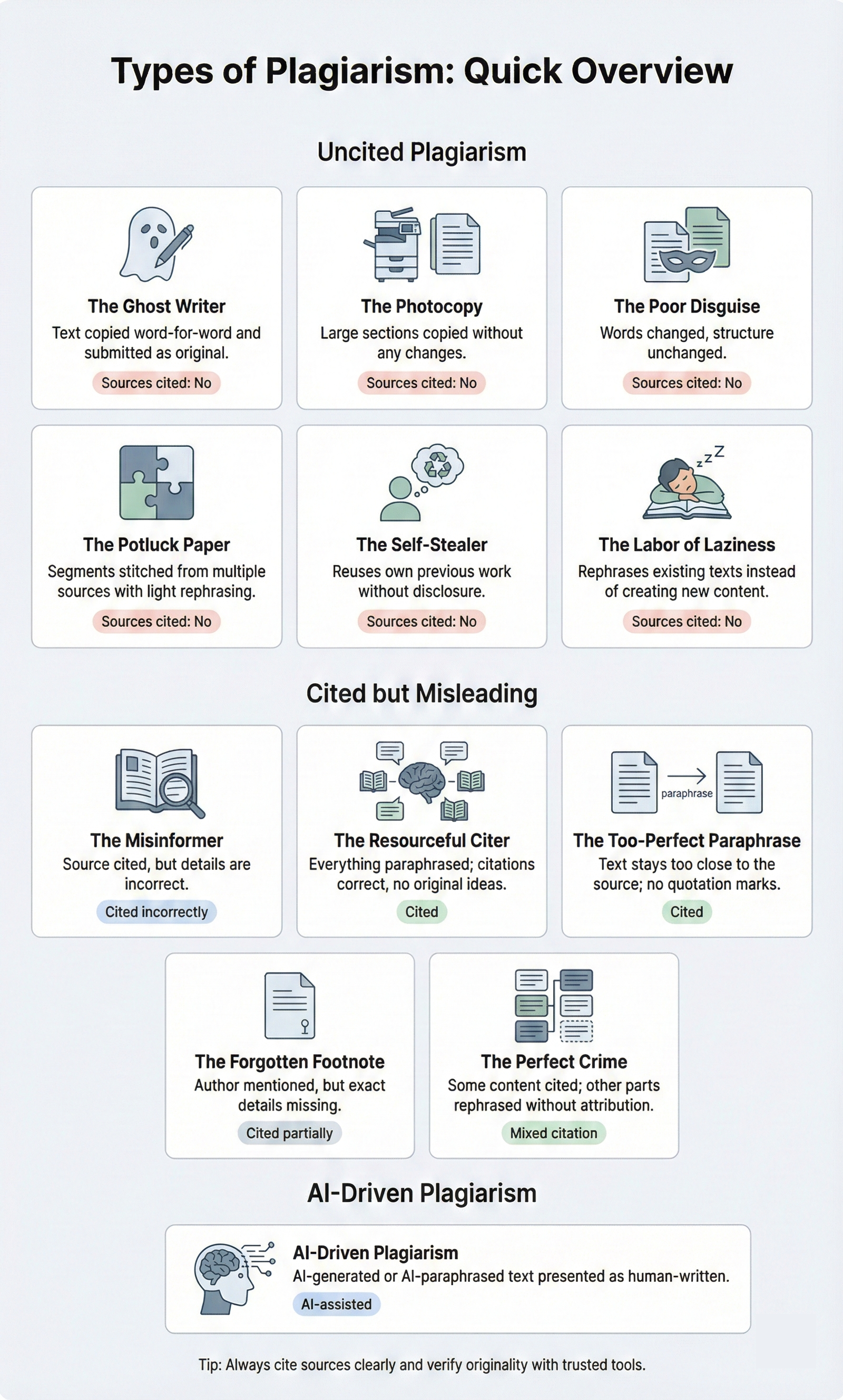The Different Types of Plagiarism
Plagiarism is more than just “copying” or “borrowing” someone else’s words. It is the use of another person’s ideas, structure, or exact wording without proper acknowledgment, and it can occur in many different ways. In education, publishing, business, and online content creation, understanding how plagiarism works is the first step toward preventing it.
Today, writers can reuse their own work, patch together paragraphs from multiple sources, or rely on AI tools to generate text. Some of these practices may look harmless on the surface but still count as plagiarism if the original sources are not clearly credited. The list below describes the classic types of plagiarism, followed by a new form that has emerged with AI-assisted writing.
Uncited Plagiarism Types
These forms of plagiarism occur when sources are not cited at all. The reader is led to believe that the entire text is completely original.
The Poor Disguise
In this type of plagiarism, writers change how the source looks by altering phrases and keywords while keeping the original structure and main ideas. The text may appear different at a glance, but the underlying content is essentially the same as the source.
The Ghost Writer
Here, the work of another person is copied verbatim and passed off as the writer’s own. There is no attribution, no quotation marks, and no indication that the text belongs to someone else.
The Photocopy
In this form of plagiarism, large or important parts of another person’s work are copied without any changes. Unlike the Poor Disguise, the plagiarist does not even attempt to rephrase or modify the content.
The Potluck Paper
The Potluck Paper is created when sentences and passages from multiple sources are stitched together into a single text. The writer may slightly alter the wording so the pieces fit together, but the original phrasing and ideas are mostly retained. These efforts are made to conceal the extent of copying.
The Self-Stealer (Self-Plagiarism)
In this case, the writer does not borrow from others but from their own previously submitted or published work. Reusing substantial parts of earlier writing without disclosure violates originality expectations in most academic and professional settings.
The Labor of Laziness
Rather than doing original research or developing new ideas, the writer spends time rephrasing sentences from existing works and fitting them together. The result may look like a new text, but the intellectual contribution is minimal because the content is built on borrowed ideas.
Cited Plagiarism Types
In the following forms, sources are mentioned, but the way they are used is still misleading or dishonest. The appearance of proper citation hides deeper problems with originality.
The Misinformer
The Misinformer is a type of plagiarism in which the source details are incorrect or incomplete. Because the information about the source is wrong, the reader cannot locate or verify it. The reference gives the illusion of transparency without allowing real checking.
The Resourceful Citer (a.k.a. The Resourceful Writer)
In this form, all sentences are rephrased from other sources, and the citations and quotations are technically correct. The problem is that nothing in the text is truly original. It looks like a well-researched paper, but the writer has contributed very little beyond reorganizing other people’s ideas.
The Too-Perfect Paraphrase
Here, the source is cited, but passages that closely follow the original wording are not placed in quotation marks. The paraphrase is so close to the source that it is essentially a disguised copy, even though a citation is present.
The Forgotten Footnote
In the Forgotten Footnote, the writer mentions the author’s name or work but omits specific details about where the material came from. By hiding the exact location of the source, the plagiarist makes it difficult to check how much of the text was borrowed and whether it was used fairly.
The Perfect Crime
In this sophisticated form of plagiarism, the writer cites sources for some information while rephrasing other sentences without attribution. The cited parts make the paper look honest, while the uncited paraphrases are presented as the writer’s own analysis or evaluation. This mixture of credited and uncredited borrowing can be hard to detect.
AI-Driven Plagiarism
With the rapid growth of AI writing tools, a new category of plagiarism has appeared. AI-driven plagiarism occurs when a writer uses text generated or heavily assisted by artificial intelligence and presents it as original human work without disclosure or proper citation.
AI-driven plagiarism can take several forms:
- Submitting AI-generated essays, articles, or reports as if they were written entirely by the author.
- Using AI tools to paraphrase or “spin” existing sources to hide direct copying instead of engaging with the material.
- Combining AI-generated content with small edits so the text appears personal while still relying on machine-produced ideas and wording.
Even when no single human source is copied word for word, AI-generated text can reproduce patterns, arguments, or phrasing learned from vast training data. Many institutions now treat undisclosed AI authorship as a form of plagiarism or academic misconduct. To stay on the safe side, writers should follow their institution’s policies, be transparent about how AI tools are used, and always give proper credit when the output is based on specific sources.
Summary Table: Quick Comparison of Plagiarism Types
| Type of plagiarism | Sources cited? | What happens | Detection difficulty |
|---|---|---|---|
| The Poor Disguise | No | Phrases and keywords are changed, but the structure and ideas closely follow one source. | Medium |
| The Ghost Writer | No | Text is copied verbatim from another author and submitted as original work. | Easy |
| The Photocopy | No | Large or important sections of another work are copied with no changes at all. | Easy |
| The Potluck Paper | No | Sentences from multiple sources are stitched together with only light rephrasing. | Medium |
| The Self-Stealer | No (and often undisclosed reuse of the author’s own work) | Significant parts of the writer’s previous work are reused without clarification or permission. | Medium |
| The Labor of Laziness | No | Existing sources are heavily rephrased and combined instead of creating new ideas. | Medium |
| The Misinformer | Yes, but with wrong details | Source information is inaccurate or incomplete, so readers cannot find the original. | Medium |
| The Resourceful Citer | Yes | Almost every idea is borrowed and rephrased; citations are correct, but there is little original contribution. | Hard |
| The Too-Perfect Paraphrase | Yes (no quotation marks) | The wording is very close to the original source, but it is presented as a paraphrase without quotation marks. | Medium–Hard |
| The Forgotten Footnote | Partly (vague) | The author is mentioned, but precise source details are omitted, hiding how much material was borrowed. | Medium |
| The Perfect Crime | Yes and No (mixed) | Some information is cited correctly, while other passages are rephrased without attribution and presented as original analysis. | Hard |
| AI-Driven Plagiarism | Often unclear or undisclosed | AI tools generate or heavily rewrite text; the writer presents it as their own work without disclosure or proper credit to underlying sources. | Medium–Hard |
Infographic: Visual Guide to Plagiarism Types

How to Detect and Prevent These Types of Plagiarism
Recognizing these patterns is only half the job. The next step is building habits that reduce the risk of plagiarism in any form. Keep detailed notes on your sources, distinguish clearly between your own ideas and borrowed material, and allow enough time for proper citation instead of last-minute patchwriting.
Modern plagiarism-checking and AI-detection tools can help you verify that your text is original before you submit it. Regular self-checks are especially useful for collaborative projects, frequent online publishing, or work that mixes research, quotation, and AI-assisted drafting.
If you want to review your own writing, you can run it through a reliable plagiarism checker or explore practical tips in guides such as How to Avoid Plagiarism. These resources make it easier to catch problems early and revise them ethically.
Plagiarism is not a single act but a spectrum of behaviors, ranging from obvious copy-and-paste to subtle misuse of citations or AI tools. By understanding the different types of plagiarism and how they appear in real texts, writers can make more informed choices, protect their reputations, and show genuine respect for the work of others.
